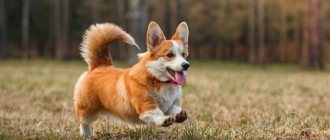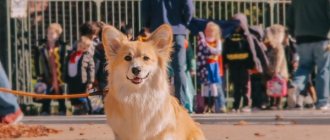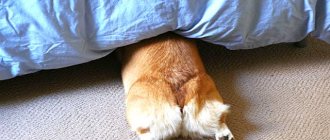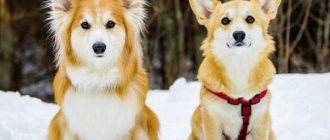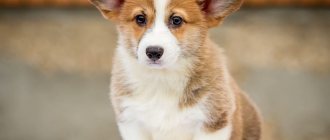Origin of the breed
Pembroke is a very ancient breed. Its origin is shrouded in myths and legends. According to a wonderful English legend, Pembroke Welsh Corgis served as horses for fairies and elves. The fur on the backs of the dogs, very similar to a small saddle, reminds us of the “racing” past. This is especially noticeable on sable-colored dogs.
As for earthly theories about the origin of the breed, they look like this:
- In England, it is believed that modern corgis are the fruit of love between Spitz-type dogs and local dogs. The first were brought with them by Flemish weavers who arrived in England at the invitation of King Henry I in 1107. Most of the newcomers settled near Pembrokeshire, in honor of which the corgi received its current name.
- In Scandinavia they are sure: if not for the Swedish Vallhund, the British would not have dreamed of having their own breed. In ancient times, the Vallhunds constantly accompanied Scandinavian sailors, who had close trade contacts in England. As a result, the Scandinavians brought several of their dogs there, they crossed with the locals, people slightly adjusted the resulting short-legged dogs and passed them off as their own breed.
Short legs are the result of human intervention. People needed a dog that could help herd cattle, that could maneuver between cow's legs and avoid being hit by its hooves.
Interesting facts about corgis
A big fan of corgi dogs is, as already mentioned, Queen Elizabeth II of Great Britain, who kept these pets at court all her life. When the time came to say goodbye to her favorites, Her Majesty was terribly sad.
To strengthen the genes of the breed and avoid the death of the corgi from cancer in the future, the queen came up with the idea of crossing her dogs with the dachshund Pipkin, which belonged to her sister Margaret. So Dorgi puppies were born, but not a single federation recognized the new breed. Let it go! But Elizabeth II could not get enough of her pets Vulcan and Candy, who emerged from this union.
photo: news.myseldon.com
At the age of 18 in 1944, the Queen got a corgi dog named Susan. All subsequent generations of royal corgis (and there were as many as 14 of them) came from the royal favorite. Elizabeth II surrounded herself with her beloved pets for 70 years, raising 30 dogs. The Queen loved her dogs so much that every Christmas she always hung stockings with gifts for each of them.
Dogs accompanied Elizabeth II everywhere - both on trips and at official receptions. So some corgis visited the White House to meet with George Bush. Elizabeth II chose her car so that there was room for her pets, so she abandoned the traditional Jaguar in favor of a Daimler. The monarch never sold her puppies, but gave them away to good hands.
The last corgi dog, Willow, died of cancer in April 2022, and Her Majesty has not had any new puppies since then. She had a hard time with the departure of her faithful four-legged friend and is afraid that she will not have time to raise another one.
Learn more about the Welsh Corgi dog breed from the video:
FCI standard
Pembroke Welsh Corgis belong to FCI Group I - herding and cattle dogs. Breed standard No. 39 was approved on December 1, 2010.
- GENERAL APPEARANCE: A short, strong, well-built, alert and active dog, despite its small size it gives the impression of great strength both in body and spirit.
- IMPORTANT PROPORTIONS: The length of the muzzle corresponds to the cranial part of the head as 3 to 5.
- BEHAVIOR/TEMPERAMENT: Determined appearance of a working dog. The behavior is open, friendly, without a trace of aggression or nervousness.
- HEAD: In shape and appearance it resembles a fox, the expression is lively and intelligent.
- CRANIAL REGION: Skull: Fairly wide and flat between the ears. Transition from forehead to muzzle: Moderately pronounced.
- FACIAL REGION: Nose: Black. Muzzle: Slightly tapered. Jaws/Teeth: Strong, with an ideal regular scissor bite, i.e., the teeth of the upper jaw overlap the teeth of the lower jaw in close closure and are set vertically in the jaws.
- EYES: Straight set, round, medium size, brown, harmoniously combined with coat color.
- EARS: Erect, medium size, tips slightly rounded. A line drawn from the tip of the nose to the eye should, when continued, pass through the tip of the ear or close to it.
- NECK: Quite long.
- BODY: Medium length, not shortened at the lumbosacral region, slightly tapering when viewed from above. Topline: Straight. Chest: Broad and deep, well let down between the forelegs. The ribs are well sprung.
- TAIL: Short, preferably natural length. Docked: Short. Undocked: Set on in line with the topline (in continuation of it). When in motion or in an excited state, the natural carriage of the tail is above the topline.
- LIMBS FOREQUARTERS: Shoulder blades: Set obliquely and making an angle of 90 degrees with the humerus bones. Shoulders: Slightly curved, repeating the shape of the chest, as if covering it. Elbows: Close to the sides, neither loose nor tied. Forefeet: Oval, toes strong, arched and tightly closed, the middle two toes projecting slightly forward of the outer two, the pads strong and rounded. The claws are short.
- HINDQUARTERS: General appearance: Strong and flexible. Legs are short. The bone is wide all the way to the paw. Knees: Well angulated. Hock joints: When viewed from behind, the hocks are straight. Hind feet: Oval, toes strong, arched and tightly closed, the middle two toes projecting slightly forward of the outer two, the pads strong and rounded.
- GAIT/MOVEMENT: Loose and active, neither loose nor stiff. The forelimbs move with good reach, without excessive lifting, in balance with the hind limbs when the latter performs pushing movements.
- COAT: Coat: Medium length, straight, with a dense undercoat, never soft, wavy or harsh. Color: Actually, red, sable, fawn, black and tan, with or without white markings on the legs, chest and neck. A little white on the head and muzzle is acceptable.
- HEIGHT AND WEIGHT: Height at withers: Approximately 25 - 30 cm. Weight: For males -10 -12 kg; Bitches –9 – 11 kg.
- FAULTS/DEFECTS: Any deviation from the above provisions should be considered a defect, the assessment of which must be made in strict accordance with the degree of its severity and effect on the health and welfare of the dog, as well as the possibility of its traditional use.
- DISQUALIFYING VICES: Aggression or cowardice. Any dog clearly exhibiting physical or behavioral abnormalities must be disqualified.
- NOTES: Males must have two normally developed testes, fully descended into the scrotum. Only functionally and clinically healthy dogs with breed-specific characteristics can be used for breeding.
What you need to know about colors
Breed standards apply not only to the appearance of animals, but also to their coloring. You can learn more about the colors of Cardigans and Pembrokes in the following table.
Suits according to standard
| Cardigan | Pembroke |
| brindle | red |
| sable | deer |
| red | sable |
| black with stripes | black with red tan |
| black and blue | |
| gray-haired | |
| marble | |
| blue merle |
Both breeds are allowed to have markings, regardless of the main color, but the predominance of white is a defect.
Pembrokes are characterized by the presence of elastic and elastic guard hairs. The undercoat does not get wet, has a dense structure and may be darker than the coat itself. The wool should not be excessively soft or harsh. The length depends on hereditary characteristics, gender, and the conditions in which the dog lives.
Cardigans have a semi-long coat that fits tightly to the body. The undercoat is not too thick, but well developed. Tails with noticeable feathering (long decorative hairs).
Character of the breed
Corgis are simply magical! They are smart, active and vigilant, and are easy to train.
The main character quality is a friendly attitude towards people.
A true “korzhonok” will politely sniff a stranger and may even allow himself to be stroked. Some individuals joyfully greet a stranger by wagging their tail (or the rest of it), squealing with pleasure and trying to kiss their new acquaintance.
The second feature of “Korzhiki” is activity. The dogs are small in size, but have more than enough energy. Representatives of the breed favor long walks, are happy to run after a ball or a puller, but you can keep silent about the love of training - this is a shepherd dog.
The third point is that corgis are for any “kipish”, except for a hunger strike. Dogs like to be aware of all the events around them, pets readily take part in them. Looking at cute animals, it seems that they are never in a bad mood. “Korzhik” always smiles, thanks to the peculiarities of the color of his face.
Courage is the fourth character trait worth paying attention to. Unfortunately, excessive fearlessness is the Corgi's enemy. A small dog considers itself big and dangerous, so it can easily get into a fight with a larger relative. And also, representatives of the breed are sure that they cannot find a better guard. Therefore, as soon as they hear the doorbell, pets begin to bark loudly and loudly, telling uninvited guests that the house is guarded.
And the fifth, perhaps most important, point - corgis are very smart. Little Shepherds just love to learn new things! Training for them (with the right approach) is a fascinating process, during which the pets’ eyes light up and the smile never leaves their faces.
Breed Features
Despite their developed intelligence and friendliness, there are many refuseniks among the “Korzhiks”. First of all, this is due to the fact that when purchasing a dog, people are sure: Corgis are equal to Yorkies or Chihuahuas. Small, sweet, they don’t require a lot of time for walking, and they don’t need training at all.
Cute dogs are shepherds that require both long walking and mental stress.
In the absence of these, the dog begins to go crazy from idleness, destroy the apartment and show its owners its teeth. And some “korzhiki”, in addition to the above, also bite their owners.
- Your pet's brain must be exercised.
- Corgis can be noisy. Being overly alert and reacting to various sounds, the pet is capable of barking at the slightest rustle. Screams outside the window, the noise of the elevator or on the staircase, the barking of someone else's dog are irritants for the “korzhonka”. Constant barking of a pet, when living in an apartment building, can become a source of conflict with neighbors. Of course, not all representatives of the breed are loud, but such dogs do exist.
- “Korzhiki” are jealous. Keeping with other dogs and cats is possible, but you should be prepared for jealousy on the part of a small shepherd.
- Dogs love to sing. “Korzhni songs” begin when pets are very happy about something. The animals growl, howl and squeal at the same time, making sounds vaguely reminiscent of “uru-ru”. Uninitiated people are frightened by these “uru-rushenki”, mistaking them for a threatening warning from the dog.
- Excessive attachment of some individuals to the owner. Thanks to this, the “shortbreads” follow their owners with their tails, trying not to leave them alone for even a minute. Such love on the part of a pet leads to inconvenience, because dogs require increased attention.
Speaking about the breed as a whole, not all of its representatives have these characteristics.
Dog personality
Corgis are known for their quick intelligence and strength. They are active, cute dogs and never want to be left out of the action. In their own minds they are big dogs in small bodies.
Like all kinds of farm dogs, corgis undoubtedly hunted pests and guarded the homestead as well as livestock. Corgis need exercise and training with a firm but kind hand to get the most out of their talents.
The Corgi may be prone to excessive signal barking and may also dig or eat a lot if not exercised. They want to be part of the family and do not survive in kennels. Most Corgis are friends with other pets and children if they were raised with them. Beware that they will sometimes chase and nip the heels of small children due to their instinct to guide livestock while grazing. This dog perceives a small child as a lost lamb.
Common diseases
Diseases of the breed are divided into two types: genetic and acquired. Genetic ones include:
- Cataract. Changes in the structure of the eye lens lead to blindness.
- Corneal dystrophy. Corgis are susceptible to epithelial dystrophy, which damages the top layer of the cornea. Characteristic signs are clouding, erosions and ulcers of the cornea.
- Degeneration or malformation of the discs between the cervical vertebrae. This disease often requires surgery.
- Spinal cord damage. The disease begins in puppyhood, but fully develops only when the dog reaches 8 years of age.
- Bleeding disorder (Willeband's disease). The disease is poorly studied.
- Epilepsy. The disease can begin both at a young and old age. Clinical signs are seizures.
- Narcolepsy is a disease of the central nervous system characterized by sudden falling asleep and paralysis of the body upon awakening.
- Ehlers-Danlos syndrome. Lack of sensitivity and elasticity of the skin.
- Cystinuria is the appearance of cystine in the urine.
- Lack of immunoglobulin – lack of high immunity and susceptibility to various infections.
Acquired diseases:
- Obesity. Corgis love to eat delicious food, which is why they look like balloons with legs. The owner must monitor the pet’s diet and not overfeed it.
- Allergy. Most often, it occurs due to incorrectly selected food or its sudden change. It manifests itself in the form of irritation, red dots on the ears, chin and stomach, the dog is constantly itching.
- Raw eczema. The fur at the site of eczema sticks together, dandruff forms, and an unpleasant odor appears. Eczema occurs as a result of poor diet or swimming in open water. Helping your pet consists of trimming the fur around the wound and treating it, for example, with “chemi-spray.”
- Difficult childbirth. It would be a stretch to call it a disease. Most bitches have to have a caesarean section due to large fetuses.
Health
Among the diseases of the Welsh Corgi, the most common is hip dysplasia. The disease is congenital and usually its presence can be easily determined using an x-ray. Most purebred animals undergo such examination.
Bitches have rather weak labor, which is why they often need surgical assistance during childbirth. In approximately 50% of cases, a caesarean section is performed. This is caused by both the large weight of each puppy - approximately 500 grams, and the narrow, long birth canal.
Eye diseases occur. Congenital genetic diseases are unlikely. For example, Welsh Corgis rarely suffer from heart disease or hemophilia. Common diseases also include: epilepsy, corneal ulcerations, obesity.
At two months, puppies are vaccinated with a complex vaccine. It is repeated after two to three weeks, then done again at 7 months and at 1 year. Subsequently, vaccination must be repeated every year in order to prevent the occurrence of various diseases.
Maintenance and care
Representatives of the breed are quite simple to maintain. The pet requires a bed or a special cage, bowls for food and water, regular walks, training and attention from the owner.
Key features of caring for a Corgi:
- The dog needs to be brushed twice a week. During autumn and spring molting, the pet is combed daily.
- Examine the animal's ears, eyes and mouth every day. The inside of the ear should be pink, clean, and without any specific odors. The eyes are clean, without “tearing” or other discharge, the oral cavity is pink, without any unpleasant odors from the mouth. Teeth without yellow plaque or tartar.
- Trim nails once every three weeks or month.
- Spend at least two hours walking your dog every day. Alternate active games with the training process.
The most important point is not to forget about annual vaccinations and preventive visits to the veterinarian.
Nutrition
Now there is a lot of controversy regarding mixed feeding of dogs: dry food + natural products. Whether this type of nutrition is correct is still unknown, so let’s talk about its usual types: either dry food or “natural” food.
Dry food is divided into four types: economy, premium, super-premium and holistic classes. Holistic and super-premium foods are considered the best in terms of balance and nutrient content. The packaging indicates how many grams per day to give to your pet, depending on its weight.
With natural nutrition it is more difficult, due to the need to independently calculate the norms. The Internet is replete with calculation tables, breeders recommend certain proportions, dog owners advise others, but in the end, everything turns out to be individual.
For those who want to feed their “korzhonka” natural products, there is a group “Lunch for Greyhounds”. There is a lot of useful information about feeding natural foods.
The only thing that can be said about “natural” food: more meat and vegetables, less grains. Gone are the days when dogs were fed porridge with a minimum of meat.
Training and education
Raising a puppy begins as soon as it appears in the house.
The golden rule for a dog lover: if something cannot be done, then do it on an ongoing basis.
When the owner forbids it today, allows it tomorrow, and forbids it again the day after tomorrow, the puppy is lost. The child does not understand what they want from him or how to behave correctly. And he independently makes decisions regarding the rules of behavior. Therefore, the consistency of the owner is the key to the success of living together with the “korzhonk”.
The second point is establishing contact with the pet. The owner’s task is to show the puppy that it is interesting and fun only next to him, to motivate the baby on himself. Motivation is achieved through games on walks and at home, the initial stage of training using positive reinforcement, joyful, timely praise and treats.
As for regular training, it is worth contacting a professional dog trainer, especially for novice dog walkers. Just please don't try to train your pet based on videos by Cesar Milan and others like him! A damaged psyche is guaranteed - it has been tested by more than one dog.
4-6 months - all over again?
The puppy has already successfully adjusted to his new world, he feels confident and sometimes pretends that you don’t exist. His character comes out, disobedience, he does not follow previously established rules. But this does not mean that he forgot everything and will have to teach him again. He just has too much energy that needs to be directed in another direction - you can start training.
At 4 months, a Pembroke Corgi puppy is able to learn the following commands:
- Movement next to the owner.
- Holding in a certain position.
- Ignoring food that is freely available.
- Prohibitions on actions.
- Basic commands: “sit”, “lie down”, “stand” and others.
- Do not raise your voice when not required.
You can start practicing agility with your puppy - overcoming obstacles with equipment.
Training for adult (over a year old) dogs differs significantly from that for a puppy, but in the case of a puppy, agility training can be combined with social adaptation and learning basic commands.
Equipment for a puppy should be chosen gradually, since he does not yet have the same physical characteristics as an adult dog. But the learning process is easier and more systematic, and puppies learn faster and more efficiently. If you want your Corgi to perform well in competitions and be out of competition, you need to start agility training at just 4 months.
Puppy cost
A good puppy cannot be cheap. Buying a “korzhik” for 10 thousand on a well-known website, a person, in most cases, receives a mongrel without documents and with a bunch of diseases.
The price for purebred puppies starts from 80,000 rubles and can reach up to 200,000-250,000 , depending on the region where the nursery is located, its popularity and the level of the puppies’ parents. In addition, mating affects pricing: if a bitch has to be taken to a stud abroad, the offspring are more expensive.
Prices
How much do Welsh Corgis cost in Russia? Puppies can be purchased for prices ranging from 20 to 60 thousand rubles. In our country they are not as popular as in Europe, they are difficult to breed, so these factors affect the cost of the breed. If private breeders offer a puppy at a ridiculous price, then this should alert you, since you may become the owner of a timid or aggressive mestizo, and not a purebred Welsh Corgi.
The average price of a puppy in Moscow is 45-50 thousand rubles. The national average is slightly different:
- A pet-class puppy can be bought for 20-25 thousand rubles.
- Representatives of the breed class - for 30-40 thousand rubles.
- Future show-class champions - for 45-60 thousand rubles.
Owner reviews
Here's what the “korzhists” say about their favorites:
Corgis are very affectionate “children” who try to give all their love. Well, be a bit of a hooligan. This is so much fun!
Do you want a lot of happiness, fun, joy and new experiences? Then feel free to get yourself a korzh, but remember that a dog is always a responsibility. She needs education, care and attention.
Do you want to get a singing creature?! Do you want a smiling dog?! The best breed in the world!
What color is happiness? Mine is red and white. Or maybe three-color. Happiness is a Corgi
In general, owners of charming shepherd dogs are happy that they have such dogs.
